Related Research Articles

The Piper PA-15 Vagabond and PA-17 Vagabond are both two-seat, high-wing, conventional gear light aircraft that were designed for personal use and for flight training and built by Piper Aircraft starting in 1948.

The Stinson 108 is a popular single-engine, four-seat, light general aviation aircraft produced by the Stinson division of the American airplane company Consolidated Vultee, from immediately after World War II to 1950. The 108 was developed from the prewar Model 10A Voyager.
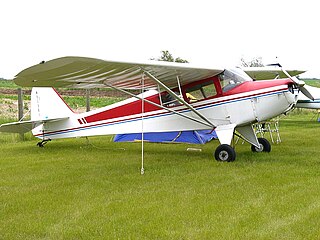
The Taylorcraft B is an American light, single-engine, high-wing general aviation monoplane, with two seats in side-by-side configuration, that was built by the Taylorcraft Aviation Corporation of Alliance, Ohio.
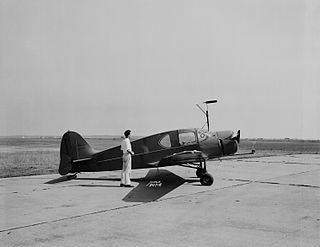
The Bellanca 14-7 Cruisair and its successors were a family of single-engined light aircraft manufactured in the United States from the mid-1930s onwards.

The Aeronca Model 7 Champion, commonly known as the "Champ", or "Airknocker", is a single-engine light airplane with a high wing, generally configured with fixed conventional landing gear and tandem seating for two occupants.
The Aeronca Model 9 Arrow was a low-wing all-metal cabin monoplane with retractable landing gear. It was marketed to returning pilots from World War II and unveiled in 1947 but never went into production.

The Auster J/1 Autocrat was a 1940s British single-engined three-seat high-wing touring monoplane built by Auster Aircraft Limited at Rearsby, Leicestershire.
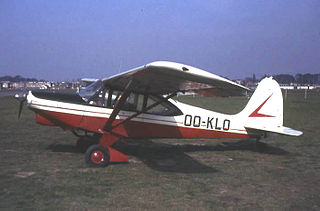
The Boisavia B.60 Mercurey was a series of four-seat light aircraft developed in France shortly after World War II.

The Klemm Kl 107 was a two-seat light aircraft developed in Germany in 1940. It was a conventional low-wing cantilever monoplane of wooden construction with fixed tailwheel undercarriage. Wartime production totalled only five prototypes and some 20 production machines before the Klemm factory was destroyed by Allied bombing. Following World War II and the lifting of aviation restrictions on Germany, production recommenced in 1955 with a modernised version, the Kl 107B, of which Klemm built a small series before selling all rights to the design to Bölkow. This firm further revised the design and built it as the Kl 107C before using it as the basis for their own Bo 207.

The Call-Air Model A is an American two- to three-seat utility aircraft designed by the Call brothers and built by the Call Aircraft Company, later developed into a successful line of agricultural aircraft.

The Funk Model B is a 1930s American two-seat cabin monoplane designed by Howard and Joe Funk. Originally built by the Akron Aircraft Company later renamed Funk Aircraft Company.
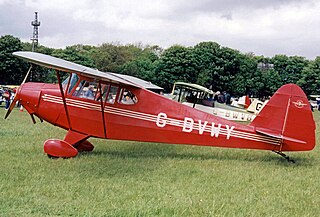
The Porterfield Collegiate is an American-built two-seat training and touring monoplane built by the Porterfield Aircraft Corporation of Kansas City.

The FMA 20 El Boyero ("Shepherd") was a light utility aircraft produced in Argentina in the 1940s. It was a conventional high-wing strut-braced monoplane with a fixed tailskid undercarriage, seating two side by side in an enclosed cabin.
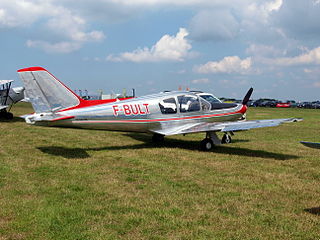
The Procaer F.15 Picchio is an Italian-designed light utility aircraft built by Procaer.

The Meyers MAC-125 is a light sport aircraft developed in the United States in 1947, produced in a small series as the MAC-145.
The Taylorcraft Model 20 Ranch Wagon was a four-seat cabin monoplane designed and built by Taylorcraft Aircraft as a development of the earlier experimental Model 18. The Model 20 was constructed of moulded fibreglass over a tubular framework. It had a conventional landing gear and a nose-mounted 225 hp (168 kW) Continental O-470-J engine.

The Robin R.1180 Aiglon is a French four-seat touring and training monoplane designed and built by Avions Robin.
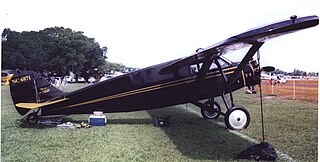
The Stinson Junior was a high-winged American monoplane of the late 1920s, built for private owners, and was one of the first such designs to feature a fully enclosed cabin.

The Ambrosini Rondone is an Italian-designed two/three-seat light touring monoplane of the early 1950s.

The Taylorcraft F22 is a two-seat American light aircraft produced in small numbers by Taylorcraft in the late 1980s and early 1990s. It is a further development of the Taylorcraft F-19 via the F-21 design. Manufacturing and marketing of the F22 was halted by the financial difficulties of Taylorcraft, although plans to restart production existed in 2007.
References
Bibliography
- "Aircraft Inquiry". Federal Aviation Administration . Retrieved May 28, 2024.
- Bridgman, Leonard (1947). Jane's All the World's Aircraft 1947. London: Sampson Low, Marston.
- "Briefing for Dealers & Distributors". Aviation . Albany, New York: McGraw-Hill. 17 October 1949. p. 48.
- Davisson, Budd (April 2001). "Unknown Taylorcraft". Vintage Aircraft. Oshkosh, Wisconsin: Experimental Aircraft Association. pp. 14–18.
- Sargent, Sparky Barnes (August 2017). "The Newells' Jewel". Vintage Aircraft. Oshkosh, Wisconsin: Experimental Aircraft Association. pp. 52–58.
- Simpson, R. W. (1995). Airlife's General Aviation. Shrewsbury: Airlife Publishing.
- Taylor, Michael J. H. (1989). Jane's Encyclopedia of Aviation. London: Studio Editions.